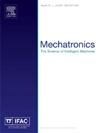基于参考轨迹在线生成的步态自学习控制,用于非对称肢体康复外骨骼
IF 3.1
3区 计算机科学
Q2 AUTOMATION & CONTROL SYSTEMS
引用次数: 0
摘要
下肢外骨骼(LEX)被广泛用于辅助有行走功能障碍的脑卒中幸存者,但它缺乏更灵活的轨迹,也无法解决康复训练中步态多变和不对称所带来的控制挑战。本文介绍了一种基于患侧参考轨迹生成的非对称自学习下肢外骨骼(AS-LEX)。根据阈值确定未受影响肢体的运动意向,从而对站立和摆动的步态阶段进行分类。在线生成参数化的步态轨迹,即站立阶段的圆形轨迹和摆动阶段的椭圆形轨迹的组合。通过步态自学习控制,患肢可以自适应地学习未受影响肢体生成的步态参数。AS-LEX 的可行性通过三名健康受试者进行了实验验证。实验结果表明,以更自然的速度(步长分别为 600 毫米和 700 毫米)在地面行走时,受试者能更积极地从未受损伤的一侧学习患侧的步态。此外,还对受影响肢体的疲劳程度和人机交互扭矩进行了实验,结果表明 AS-LEX 的步态更自然,交互力更小。本文章由计算机程序翻译,如有差异,请以英文原文为准。
Gait self-learning control based on reference trajectory generation online for an asymmetric limb rehabilitation exoskeleton
Lower limb exoskeleton (LEX) are widely used to assist stoke survivors with walking dysfunction, which is lack of a more flexible trajectory and fails to address the control challenge posed by gait variability and asymmetry in rehabilitation training. This paper introduces an asymmetric self-learning lower exoskeleton (AS-LEX) based on reference trajectory generation for the affected side. Motor intent of the unaffected limb based on thresholds was identified to classify the gait phase of stance and swing. A parameterized gait trajectory was generated online, namely a combination of circular trajectory in the stance phase and an elliptical trajectory in the swing phase. Gait self-learning control is presented to make the affected limb adaptively learn the gait parameters generated by the unaffected limb. Feasibility of the AS-LEX is demonstrated experimentally using three healthy subjects. Resuls demonstrate that overground walking in a more natural speed (with a stride length 600 mm and 700 mm) make subjects more actively learn gait of the affected side from the unaffected side. Additionally, experiments of the fatigue level of the affected limb and human-robot interaction torques were carried out, and the results indicate a more natural gait and reduced interaction forces with the AS-LEX.
求助全文
通过发布文献求助,成功后即可免费获取论文全文。
去求助
来源期刊

Mechatronics
工程技术-工程:电子与电气
CiteScore
5.90
自引率
9.10%
发文量
0
审稿时长
109 days
期刊介绍:
Mechatronics is the synergistic combination of precision mechanical engineering, electronic control and systems thinking in the design of products and manufacturing processes. It relates to the design of systems, devices and products aimed at achieving an optimal balance between basic mechanical structure and its overall control. The purpose of this journal is to provide rapid publication of topical papers featuring practical developments in mechatronics. It will cover a wide range of application areas including consumer product design, instrumentation, manufacturing methods, computer integration and process and device control, and will attract a readership from across the industrial and academic research spectrum. Particular importance will be attached to aspects of innovation in mechatronics design philosophy which illustrate the benefits obtainable by an a priori integration of functionality with embedded microprocessor control. A major item will be the design of machines, devices and systems possessing a degree of computer based intelligence. The journal seeks to publish research progress in this field with an emphasis on the applied rather than the theoretical. It will also serve the dual role of bringing greater recognition to this important area of engineering.
 求助内容:
求助内容: 应助结果提醒方式:
应助结果提醒方式:


